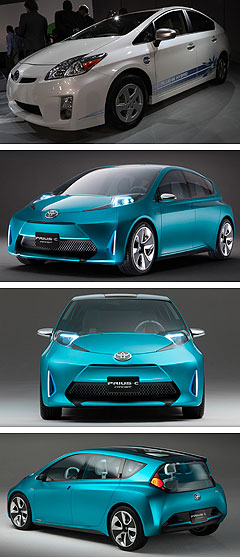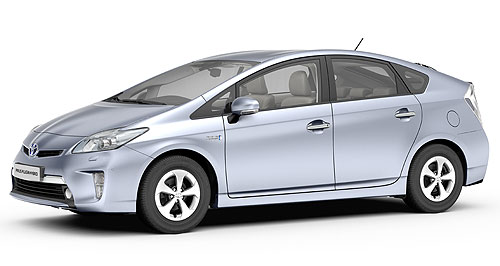Make / Model Search
Future models - Toyota - Prius - Plug-inFrankfurt show: Toyota finally plugs in PriusSwitched on: Prius PHEV will look much like the standard Prius when it eventually hits showrooms. Toyota reveals production Prius Plug-In hybrid ahead of its global debut next month15 Aug 2011 TOYOTA has revealed a better than expected European fuel consumption target of just 2.2L/100km (or some 128 miles per gallon) for its plug-in Prius hybrid, with an equally impressive CO2 emissions target of only 49g/km making it almost twice as efficient as the standard Prius. The outstanding efficiency figures for the first plug-in version of Toyota’s iconic Prius, which officially consumes 3.9L/100km and emits 89g/km, accompanied the first image of the production version that will make its global debut at next month’s Frankfurt motor show. Apart from a different front bumper, which comprises a full-length chromed bar within a slightly sportier lower grille that now also houses the foglights, the production Prius Plug-in Hybrid Electric Vehicle (PHEV) appears identical to the 600 examples that have undertaken global field trials around the world – including five in Australia – since 2009. Intriguingly, however, there is no sign of the additional ‘fuel flap’ that concealed the charging inlet on the front left quarter panel of the pre-production Prius PHEV, which was otherwise identical to the standard Prius, indicating Toyota has relocated the production model’s plug-in point. If so, Toyota has reversed the approach taken by General Motors with its Volt plug-in hybrid, concept and prototype versions of which featured a charging point that was cleverly integrated into a trademark design element near the left side mirror, before it was relocated behind a conventional ‘fuel flap’ on the left front wing – precisely the same as the production Prius PHEV.  Left: Pre-production Prius Plug-In. Below: Prius C concept. Left: Pre-production Prius Plug-In. Below: Prius C concept.In any case, Toyota has confirmed the 2012 Prius PHEV will top its regular Prius line-up in Japan, Europe and North America next year, but the ground-breaking new model remains under study in Australia, where GM has committed to selling the Volt as a Holden next year. Toyota has promised to launch its most affordable and efficient hybrid car in Australia next year in the form of the Prius C light hatchback, which will be one of two new hybrids to debut locally in 2012. The five-door Prius C, which made its debut in concept form at the 2011 Australian International Motor Show in Melbourne on July 1, will be positioned below the current third-generation Prius five-door in a growing family of petrol-electric Toyota cars. It is likely to be joined here in 2012 by a new mid-sized Prius family wagon – the five-seat Prius V or its seven-seat version, the Prius+ – which was also shown in Prius V concept form in Melbourne. Delivering on its 2009 promise to launch eight new hybrid passenger cars across both the Toyota and Lexus model ranges within four years, the Prius PHEV could be the second hybrid model Toyota Australia has committed to releasing in 2013. As GoAuto has reported previously, Toyota Australia has elected to take the Japanese-made Prius C – for City – over the Yaris hybrid that was unveiled at the Geneva motor show in March. Five examples of the manually rechargeable Prius, which is also the first Prius to employ lithium-ion battery technology instead of the conventional model’s nickel metal hydride battery pack, remain in the middle of a three-year real-world trial in Australia. Toyota Australia spokesman Mike Breen said no decision would be made about the Prius PHEV’s local fate until the results of the fleet trial were known. “The trial is ongoing,” he told GoAuto this week. “We’re waiting for an outcome from that testing, which will evaluate all aspects including charging infrastructure, before we decide where to go to from here.” In a press release issued late last week, Toyota Motor Europe said the full-hybrid Prius PHEV would join the Prius, the British-built Auris hybrid, the seven-seat Prius+ and the new Yaris hybrid in Toyota’s hybrid model range. “The new Prius Plug-in Hybrid features a new, more compact lithium-ion battery which has been developed to meet Toyota’s rigorous standards for reliability,” said Toyota. “The new battery offers extended EV (electric power only) range, enabling the Prius PHEV to achieve the remarkable fuel efficiency of just 2.2L/100km, and to lower CO2 emissions to 49g/km, almost half the standard Prius. “While some debate the relative merits of electric cars, the new Prius Plug-in Hybrid offers drivers the best of both worlds extended EV driving range for shorter journeys in towns and cities, while the efficient hybrid petrol engine gives the car uncompromised long-range capability and the very low fuel consumption of the standard Prius. “The Prius Plug-in Hybrid represents the latest development of Toyota’s Hybrid Synergy Drive (HSD) system. This trusted and reliable full hybrid technology has a track record earned through worldwide sales of over two million cars and billions of miles of driving.” The Prius C will be priced lower than the current Prius hatchback, which now starts at $34,990 after the entry price was slashed by $5000 in April, and could also undercut the cheapest hybrid currently available in Australia – Honda’s $29,990 ‘mild hybrid’ Insight five-door hatchback. However, if it is sold here, expect the Prius PHEV – which Toyota previously said would return fuel consumption of around 2.6L/100km – to command a price premium over existing hybrid models, the flagship ‘i-Tech’ version of which costs $45,990. Like all models in the expanding Prius model family, the plug-in version of the mainstream MkIII Prius hatchback launched here in July 2009 combines a 73kW/142Nm 1.8-litre petrol engine with a 60kW/207Nm electric motor. The PHEV model gains the ability to externally recharge its 5.2kWh Li-Ion battery, however, extending its electric-only driving range from about 2km to 20km – about a third of the range offered by the Volt and Nissan’s similarly sized Leaf, which will join Mitsubishi’s pioneering i-MiEV city-car as Australia’s second factory EV. Toyota Australia sales and marketing chief David Buttner said last October the Prius PHEV’s 20km range was dictated by studies of typical driving distances in Europe, which revealed that 80 per cent of car journeys were of less than 25km. He conceded that a 20km EV driving range was unlikely to be enough for Australians, but said the Prius PHEV’s on-board petrol engine would eliminate the ‘range anxiety’ typically associated with all-electric vehicles. “If you forget to plug it in, you will still be able to drive to work, and you will be able to continue to drive beyond the range of the battery pack,” said Mr Buttner at the time. “Unlike electric cars, you will not have to drive with one eye on the road and one eye on the electric power gauge. After using its electric-only range, the PHEV reverts to normal petrol-electric hybrid operation, such as that of Prius or Hybrid Camry.”  Read more27th of June 2011  AIMS: Toyota confirms city PriusThrifty Toyota Prius C to set new hybrid benchmark when it arrives in 20127th of April 2011  Toyota slashes Prius pricesUp to $7500 cut from the price of Toyota’s pioneering Prius petrol-electric car13th of October 2010  Toyota confirms Plug-in Prius for OzToyota set to begin local trials of Prius Plug-in Hybrid ahead of 2012 introduction1st of June 2010  Toyota Prius Plug-In arrives in OzPlug-in version of Toyota’s Prius formally approved for trial on Australian roads11th of September 2009  Toyota’s plug-in Prius set for real-world trialsToyota to lease plug-in Prius hybrid from early 20102nd of September 2009  First look: Toyota hybridises Corolla, plugs in PriusToyota Auris Hybrid and plug-in Prius concepts previewed ahead of Frankfurt debutAll motor show Alfa Romeo Alfa Romeo Abarth Abarth Alpine Alpine Alpina Alpina Audi Audi Aston Martin Aston Martin BMW BMW Bentley Bentley Chery Chery Brabham Brabham Chrysler Chrysler Chevrolet Chevrolet Cupra Cupra Citroen Citroen DS DS Dodge Dodge Fiat Fiat Ferrari Ferrari Foton Foton Ford Ford Great Wall Great Wall FPV FPV Haval Haval GWM GWM Honda Honda Holden Holden Hummer Hummer HSV HSV Infiniti Infiniti Hyundai Hyundai Jaguar Jaguar Isuzu Isuzu Kia Kia Jeep Jeep Land Rover Land Rover Lamborghini Lamborghini Lexus Lexus LDV LDV Mahindra Mahindra Lotus Lotus Mazda Mazda Maserati Maserati Mercedes-AMG Mercedes-AMG McLaren McLaren MG MG Mercedes-Benz Mercedes-Benz Mitsubishi Mitsubishi Mini Mini Opel Opel Nissan Nissan Peugeot Peugeot Pagani Pagani Proton Proton Porsche Porsche Renault Renault Ram Ram Rover Rover Rolls-Royce Rolls-Royce Skoda Skoda Saab Saab SsangYong SsangYong Smart Smart Suzuki Suzuki Subaru Subaru Toyota Toyota Tesla Tesla Volvo VolvoMotor industry news |
Click to shareAll motor show Alfa Romeo Alfa Romeo Abarth Abarth Alpine Alpine Alpina Alpina Audi Audi Aston Martin Aston Martin BMW BMW Bentley Bentley Chery Chery Brabham Brabham Chrysler Chrysler Chevrolet Chevrolet Cupra Cupra Citroen Citroen DS DS Dodge Dodge Fiat Fiat Ferrari Ferrari Foton Foton Ford Ford Great Wall Great Wall FPV FPV Haval Haval GWM GWM Honda Honda Holden Holden Hummer Hummer HSV HSV Infiniti Infiniti Hyundai Hyundai Jaguar Jaguar Isuzu Isuzu Kia Kia Jeep Jeep Land Rover Land Rover Lamborghini Lamborghini Lexus Lexus LDV LDV Mahindra Mahindra Lotus Lotus Mazda Mazda Maserati Maserati Mercedes-AMG Mercedes-AMG McLaren McLaren MG MG Mercedes-Benz Mercedes-Benz Mitsubishi Mitsubishi Mini Mini Opel Opel Nissan Nissan Peugeot Peugeot Pagani Pagani Proton Proton Porsche Porsche Renault Renault Ram Ram Rover Rover Rolls-Royce Rolls-Royce Skoda Skoda Saab Saab SsangYong SsangYong Smart Smart Suzuki Suzuki Subaru Subaru Toyota Toyota Tesla Tesla Volvo VolvoMotor industry news |











Facebook Twitter Instagram